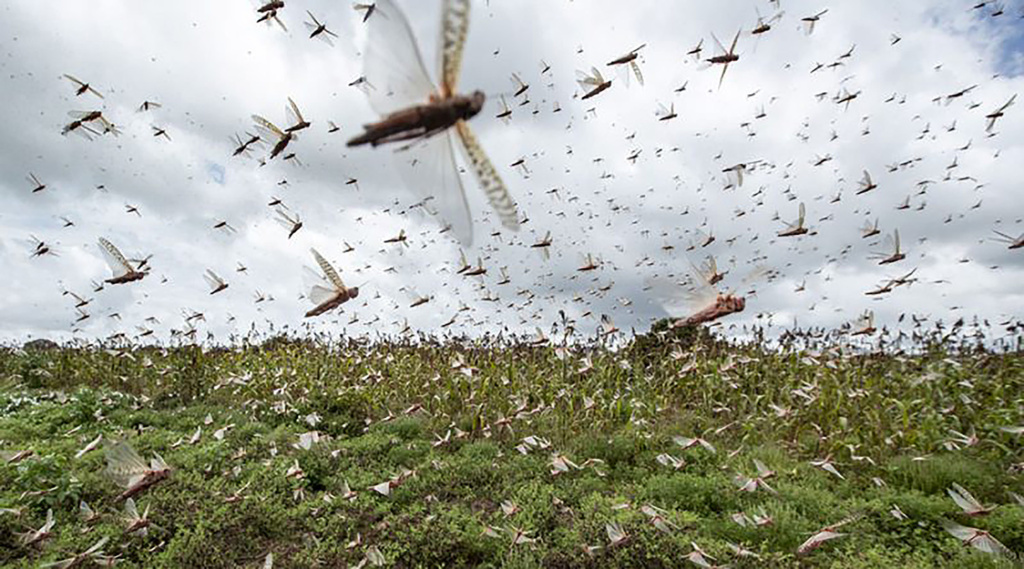The Ethiopian Ministry of Agriculture has called on its international partners to support ongoing efforts to avert desert locust-inflicted food insecurity in the country. Noting that about 3 to 5 locust swarms are currently active in parts of the East African country, the ministry stressed that the desert locust situation “is very severe which needs intervention of several stakeholders including the international community,” state-run Ethiopian News Agency (ENA) quoted officials at the ministry as saying.
Desert locusts have affected at least 173 woredas or districts across seven regions of Ethiopia since the infestation began in late 2019, causing a significant threat to food security, claims a preliminary assessment report. The Ethiopian government and its partners conducted a nationwide assessment that gauged the impact of the locust infestations on livelihoods and food security of the nation. The assessment targeted 1,600 households in 64 kebeles across 32 woredas in Afar, Amhara, Oromia, SNNP, Somali and Tigray regions, as well as Dire Dawa City Administration. Its preliminary findings indicate decreased food availability at household level as a result of the infest, says the UN humanitarian agency UN OCHA in its bulletin on Wednesday. The impact also results in a low market supply of food items and subsequent increase in market price compared to the same time last year.
“Livestock sales have increased to generate additional income to buy food and supplementary animal feed,” the report claims. “At the same time, livestock body conditions have deteriorated, and livestock price have declined, negatively affecting the terms of trade”. According to the assessment, the price of cereal has increased by an estimated 50% as of February 2020 compared to the same time last year while the price of livestock such as camels and goats have dropped slightly by more than 30% during the same period. “Affected households require food assistance for sustenance between March and July,” claims the UN agency.
The plague is now feared to aggravate the food insecurity in the country, where seven million people are in acute need of life-saving multi-sector assistance, even further. The insects, which eat their own body weight in food every day, are still breeding in southern part of Ethiopia, according to the UN Food and Agriculture Organization (FAO). Within a widespread area of Oromia and SNNPR regions, including the Rift Valley, the locusts “are forming in some places”, FAO announced on Tuesday.
“Immature swarms are present in the south where cross-border movements are likely from adjacent areas of Somalia and Kenya. Aerial and ground control operations continue,” it added. As the plague continues almost all east African nations, aerial and ground spraying combined with constant tracking of the swarms are viewed as the most effective strategies.
But Desert Locust Control Organization for Eastern Africa head Stephen Njoka told BBC News this week that aircraft were in short supply. Currently, Ethiopia was using five and Kenya six for spraying and four for surveying, he said.
As the country recently embarked on its second rainy season, the Ethiopian government is battling against time to control the spread of desert locust influx, in which the country has so far managed to spry chemical on 112,000 hectares of land infested by the desert locust swarms across different parts of the country. “The Ethiopian government is exerting maximum efforts to mobile resources from several stakeholders and partners in bid to protect the spread of locust swarms,” Sani Redi, Ethiopian State Minister of Agriculture, said. According to the state minister, the locust is expected to upsurge in Ethiopia until the end of August, in which the situation could be further exacerbated by new swarm breeding, which may produce more locust swarms.
The Ethiopian government, which has so far allocated 30 million Ethiopian birr (about $1 million) funding in addition to financial pledges from its partners to support the prevention and controlling mechanisms in the coming months, also stressed that it’s intensifying preventative and controlling measures with support from its international and bilateral partners, such as the government of China and the United Nations.
Desert locust can comfortably live in a warm, sandy environment such as Eastern Ethiopia and Somaliland. Locals, meanwhile, are engaged in their own combat operation. When a locust swarm approaches, residents try to scare them away by blowing whistles, drumming empty buckets, setting fires, and shooting into the air. The desert locust has been found on 32,000, mostly in the Oromia, Amhara and Afar regions. “the desert locusts are on grasses, shrubs and on the standing crops, attacking millet in the eastern part of the country.” A desert locust can consume roughly its own weight in fresh food per day, about two grams’ worth and the desert locust is considered a dangerous migratory pest capable of flying up to 150 kilometers a day, assisted by wind. Solitary desert locust adults fly at night and swarms fly during the day.

